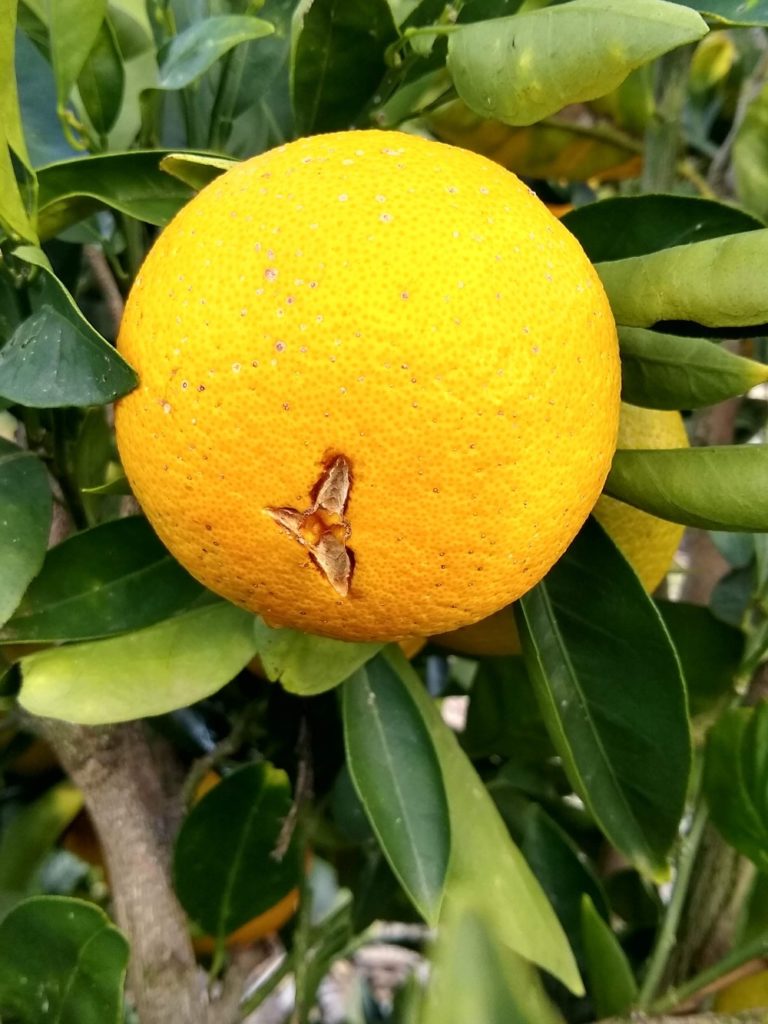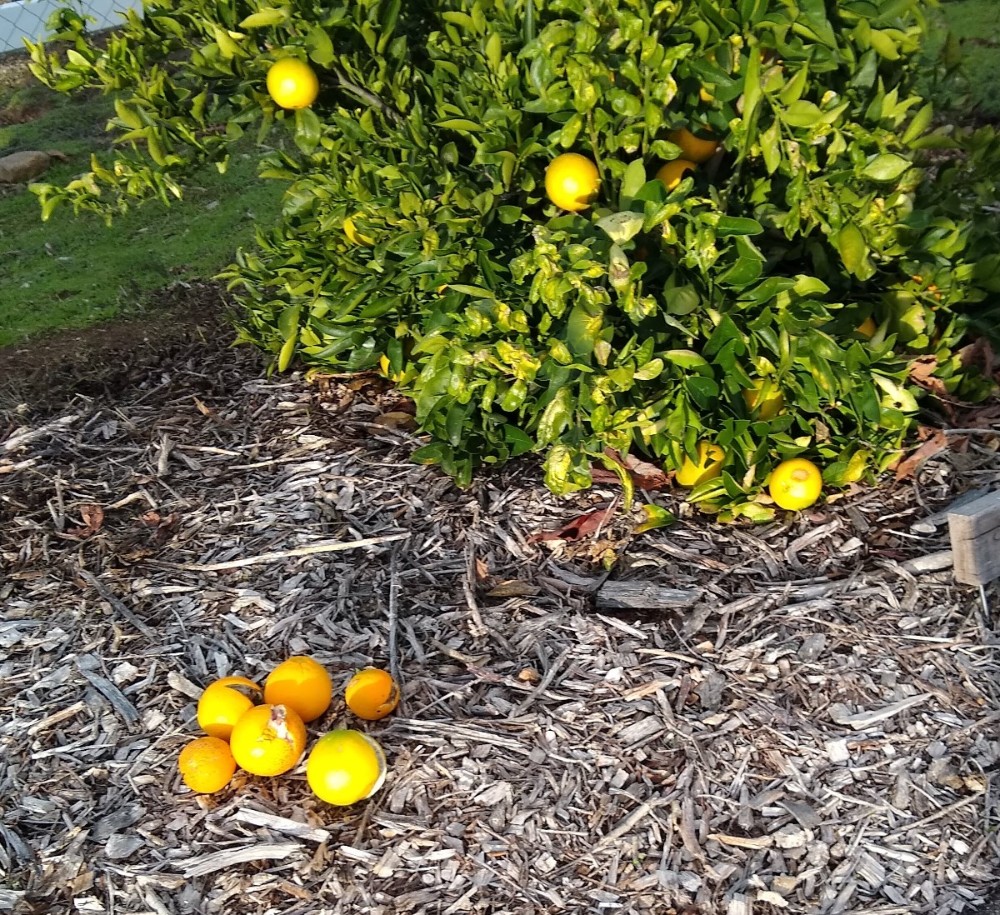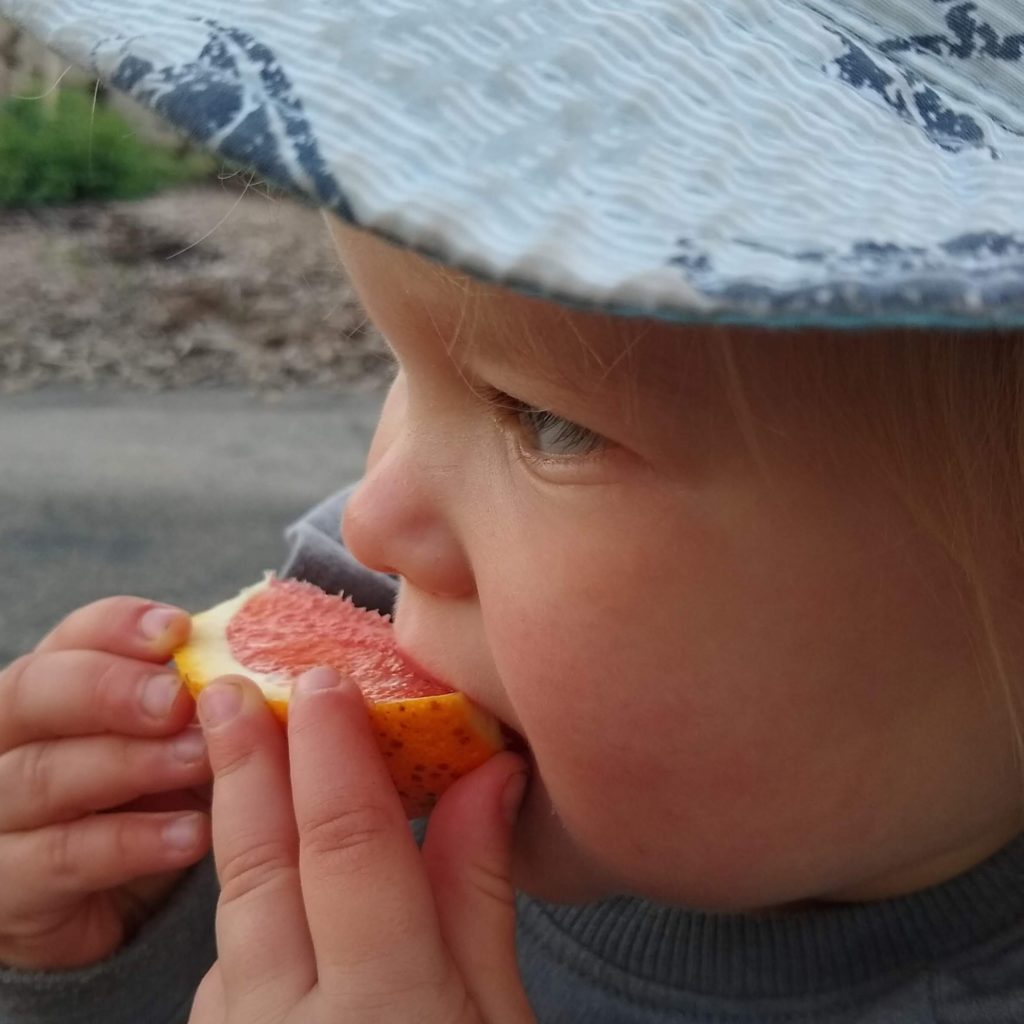It’s December, my oranges aren’t sweet yet, but they’re splitting. Oh no!
Happens every fall, actually. Just as the cool nights start to turn the rinds from green to orange, and just as the first rains arrive, navel oranges begin to split.
My orange tree whose fruit is splitting is a Cara Cara navel orange. I’m told that blood oranges and Valencia oranges also split sometimes but I’ve never seen that. I also read that some mandarins get split rinds, but out of the hundreds of mandarins of different varieties that I have on my trees I’ve found only two with split rinds. This phenomenon is a navel orange problem mostly.
Split usually starts at navel
Usually the cracking begins at the navel, the bottom of the orange, which seems to be because that navel is a weak point in the rind. It’s like a natural scratch in the rind that is the first spot to tear open under pressure.

What causes the splitting?
You’ll find some claiming to know the causes in detail. For example, one piece of research from South Africa talks of the contributions of factors such as nutrient imbalances, warm and humid climatic conditions, irregular irrigation, and heavy crop loads.
And commonly, there is a story told about the splitting of navel oranges. It goes like this: In California, the early fall weather is warm and dry. During such weather an orange tree might pull water from its fruit if it is in need of moisture. Then the glorious rains of late fall arrive. At that point, the dehydrated fruit take in more water than their skin can handle and . . . split!
One University of California Cooperative Extension farm advisor told me that he has observed that most of the trees with a lot of oranges and mandarins splitting after the first rain in fall were not watered enough before the rain — during summer and early fall.
It all sounds plausible.
Yet elsewhere there is no claim to understand exactly why oranges split. The California Master Gardener Handbook, published by the University of California, summarizes the symptom of split navel oranges this way: “Cause unknown.”
How to prevent the splits
When there is a claim to know the cause of splitting, it is often accompanied by advice as to how to reduce it. The most common advice is as follows: “The best remedy is to irrigate evenly.” A less common piece of advice is to mulch and fertilize trees appropriately.
Yet there is never any evidence given that these practices significantly and consistently reduce splitting, not to mention that the advice itself is usually so unspecific as to be hard to follow. (How exactly does one “irrigate evenly?”)
What makes sense to me is that one should water an orange tree during warm and dry times, especially during stressful Santa Ana events. If you don’t, you can see the tree cup its leaves to display its stress. So of course, water your tree enough and everything about the tree will be healthier, including the integrity of its fruit.
Beyond this basic watering, I land on the conclusion that navel oranges are still going to split to a degree. In other words, it’s still partly out of our hands, it’s also related to weather and internal tree mechanisms that we cannot or don’t know how to manipulate effectively. At least, with good watering practices, the proportion of split fruit remains small.
What to do with split oranges?
So here I am with a little Cara Cara tree carrying about 50 oranges and six of them have split this year. That’s a higher proportion than past years, but it still leaves me with about 44 good oranges. Not a big problem.

What to do with the splits? Left on the tree, they eventually gather mold and rot. You might as well pull them off before the rot gets bad. The problem is that they aren’t sweet yet so you don’t want to eat them. It’s still too early to pick navel oranges when they split here in late fall.
Or is it? Might as well taste.

Surprisingly, the split oranges were mostly worth eating. I wouldn’t call them good, but not one went straight to the compost bin after all.
You might also like to read my post:
When to pick oranges and tangerines
There are no ads on this website because of the cool Supporters who voluntarily contribute to keep my Yard Posts coming. Thank you, Supporters. You can become one today.




I’d love to know why ,after two years, I still have zero fruit on a seemingly healthy blood orange tree.
Hi Leslie,
There are many possible reasons, and one is time.
If you planted the tree from a five-gallon container, then you could have a few blood oranges on it for eating this winter, but I wouldn’t expect that. Out of the many oranges and mandarins that I’ve planted over the last few years, they’ve all borne fruit at slightly different ages and quantities, but most haven’t had more than a few pieces of fruit until they had been in the ground about three years.
This goes to say that if your tree appears healthy, then worry only if there’s no fruit set this coming spring.
We have lived in our house for two years. Both these years we had great oranges from a tree that was here when we move in. For the last couple of months most of the new oranges are splitting. It seems like we won’t have any oranges now. How can we fix our tree? It did snow 8 times in winter, hot in summer and lots of rain.
My Taracco and Moro blood oranges rarely split. Satsuma tangerines rarely split. My Tahoe Gold tangerines split about 5% and I have one Yosemite Gold that is 60% splitting. My Fukumoto oranges rarely split. My Washington and Cara Cara split about 5 to 10%, but splitting was worse last year 2018 than this year. My best guess for the reason for splitting is nutrients. I’ve read that too much nitrogen is the problem, but I think it is a lack of something, therefore I’ve been giving all my trees bone meal and gypsum. My tomatoes had end rot (lack of calcium) therefore it is reasonable to think my other soil is also lacking in calcium. Most of my trees are in the back yard on a hillside with homes on both sides. I don’t get nearly as much sun as most of my trees need.
I have a natural indicator for orange ripeness – rats. The rats sniff out the best most ripe oranges. My trail camera shows them jumping into the trees and then eating out the orange pulp leaving the shell hanging on the tree. Their #1 favorite is the Taracco and #2 is the Moro – then they graduate to the Cara Cara. I tried spraying the oranges with Malic acid and it did not stop them. I now put several traps under the tree and as they jump around they get caught. My trail camera caught one with a leg in the trap. The next video showed a hawk were the rat was last – saved my having to get rid of it. The favorite fruit of rats in my yard were the apricots – I quite growing them because my camera showed a tailgate party every night under that tree.
It’s the watering pattern. I have a marsh grapefruit tree with a lavender gem tangelo and a cocktail grapefruit grafted to it. It’s planetd in such a way that rains don’t really get it much water so I need to water it mostly via irrigation. Well before these rains began I watered it and a few weeks later my first split cocktail grapefruits showed up, shortly after the lavender gems started to split. The marsh is super hardy so really never splits. As for how I watered it, I turned on the hose and walked away essentially flooding it. Next year I’ll even it out and see what splits.
Thankyou for the video of the Stewart and Zutano, the less appreciated. In Oct. I planted: #15 Reed and Pinkerton, and #5 Jim, Mexicola Grande, Fruete, Lamb and Gwen. The Mexicola and Pinketon are growing like weeds, whereas the Reed and Gwen sit moping and dropping leaves. After killing 6 avo trees I appreciate a vigerous variety even if it’s less than the “best” tasting, any homegrown avo fruit is WONDERFUL. Can’t wait for your avo Calendar. And due to all your good planting advice you are a real tree savior.
All mine are splitting badly this year. Moro blood oranges hav about 33 percent split. Washington oranges 10-15 percent. Chandler pommelos having bad problem once they get big, they’re splitting. The citrus in general all seem to be a little smaller than last year so it leads me to
Think the irrigation was insufficient . All my trees are mulched heavily though. On average I give each tree 20 gallons per week over summer and fall. The trees are about 6-8 feet tall on average and in ground for 6-7 years.,
That’s so curious because my citrus seem to all be a little bigger than last year! Maybe it was a difference in irrigation. I watered more frequently this past summer compared to previous summers and with slightly more volume overall — but especially through early fall. All of my trees (citrus and other) seem to have appreciated the regimen, and maybe it resulted in less splitting too? Can never know for sure.
Hi Greg
I am responding a bit too late. This is about your orange splitting problem.
I think it is because of Boron deficiency. Try feeding the trees with 5-10 gms of Boric sulfate (or any other Boron) once a year. It may solve the problem.
Even in other citrus fruits like Bael, Boron deficiency can cause fruit splitting.
I had a jackfruit tree that had the same problem and got solved after I used Boron.
Hi Greg, you mentioned splitting oranges in a recent weekly newsletter. I just spent 20ish minutes looking at my dwarf naval orange tree. No splits, at least not the oranges. Somewhere in November a branch broke off the tree that had 50 or more oranges on it. I imagined it was a one off, perhaps related to the fact I thinned the inside growth for the first time in 25 years last summer. Tonight, there’s a large hole in the top of the tree, I believe from another branch VERY heavily loaded down with oranges. I picked several, and it hasn’t seemed to change things much.
Crawling inside the tree, I made some observations. The hole is NNE side of the tree, so it doesn’t get much (any?) direct sun to the inside of the tree. Perhaps the tree has been light on branches/leaves there for some time, or during last summer ‘s clean out I managed to remove enough dead branches to make this hole visible. Also, the laden branch is resting on at least two smaller branches. I can lift the branch up a bit, but it’s very heavy. There are maybe 100 oranges in that part of the tree on multiple branches. Hard to tell how many the I see leaning is carrying itself. That particular branch has multiple off shoots with smaller branches. Overall, the tree is at its peak 9 feet, at least 8 feet diameter, and covered in leaves and oranges except in the hole described above and where the branch broke off in November. I’d guesstimate the tree’s holding 300-500 oranges. It’s been an awesome tree the past several years.
Sharing this in hopes it will help others. In my previous post, I mentioned that back in November a branch broke off of my Dwarf Navel orange tree. What I didn’t mention was that I let that branch just lay on the ground next to the tree. This time of year, that spot is shaded during the middle hours of the day by an adjacent Hass tree.
When the branch broke, the oranges were more of “greens”. Some orange, but no where near ripe. Over the past 3 months I’ve eaten some of those oranges as they continued to ripen. Today, I was chipping some branches and decided it was time for the orange branch to go. There were still a few oranges attached, and over 50 on the ground below it. I gathered between 30 and 40 of those oranges and juiced them. Delicious!!
So, if you have problems with an orange tree branch breaking, and the timing is right, just sit tight and you may get to enjoy those oranges eventually.
Very cool, Matt! Where the branch broke, was it still partly connected to the tree? On branches I’ve had break, sometimes the branch will still be partly connected on its underside, and it seems that the broken branch can still have quite a bit of sap flow through that small connection.
Hi Greg — appreciate your wisdom! Regarding an earlier comment, I’m 4 years in the ground with 8 different citrus varieties. all fruiting great minus one — a blood orange. Tree is healthy and full and have not even had a flower on it in years. Any ideas? Thanks!
Hello Bob, Rick here. I might have an answer for you. About 6 years ago I purchased two pixie tangerine trees from evergreen nursery. They were very similar in size and health. I planted one in my backyard which doesn’t get much sun and I planted one in my front yard along with an oral blanco grapefruit in a massive hole I dug and filled with excellent soil. The pixie in the back today has a trunk diameter about an inch and a half and has produced fruit and is loaded this year. The pixie in the front has a trunk diameter about two and a half inches to 3 in in diameter and has produced maybe one or two fruit a year, but usually zero. The oral blanco next to it is huge and producing tons of fruit. Why that pixie in the front never produced anything is a massive surprise. Starting the year before last I cut the tree way back and left a few large branches. When it started sprouting new limbs I grafted Tahoe Gold, Shiranui, 88-2 now called supernova, Miho satsuma, and also Shasta Gold which did not take. As of today it did not grow any fruit except for shiranui which I have about seven large fruit hanging on the tree. It is January 10th 2025 today. It’ll be interesting to see this spring if any of those other varieties will set fruit on that tree. If the other varieties don’t fruit this spring then I will likely cut them off and let the shiranui take over. I hope that experience helps you with your situation.
Since my nearly 5-year old blood orange was not flowering or bearing, I followed the advice of a gardener, who said you need to kick start fruit production of a blood orange by stressing it. Hit it hard with a baseball bat several times, enough to bruise it and even slightly crack the trunk. I did that and it bore a lot of fruit the next year!